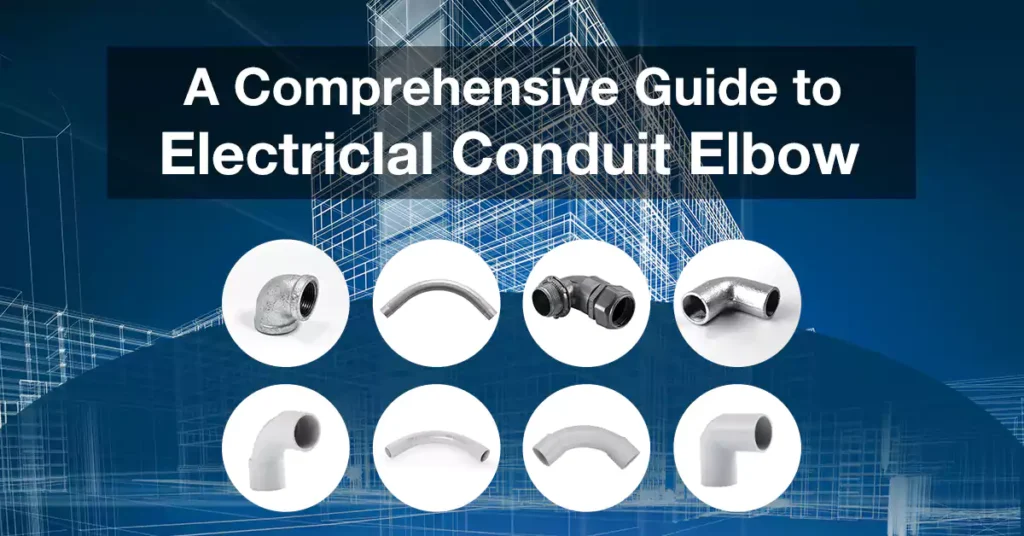
Índice
Ao lidar com instalações elétricas, o sistema de conduítes desempenha um papel vital como um componente crucial. Este sistema, que consiste em conduítes e conexões, serve ao propósito de proteger e organizar a fiação elétrica. Ao fazer isso, ele previne riscos potenciais e garante um fluxo contínuo de energia. Entre os vários acessórios disponíveis, um tipo em particular, conhecido como cotovelos de conduíte, tem importância significativa em qualquer projeto de instalação elétrica. Neste guia abrangente, exploraremos todos os aspectos essenciais dos cotovelos de conduíte para ajudar você a ter uma melhor compreensão deste encaixe de conduíte.
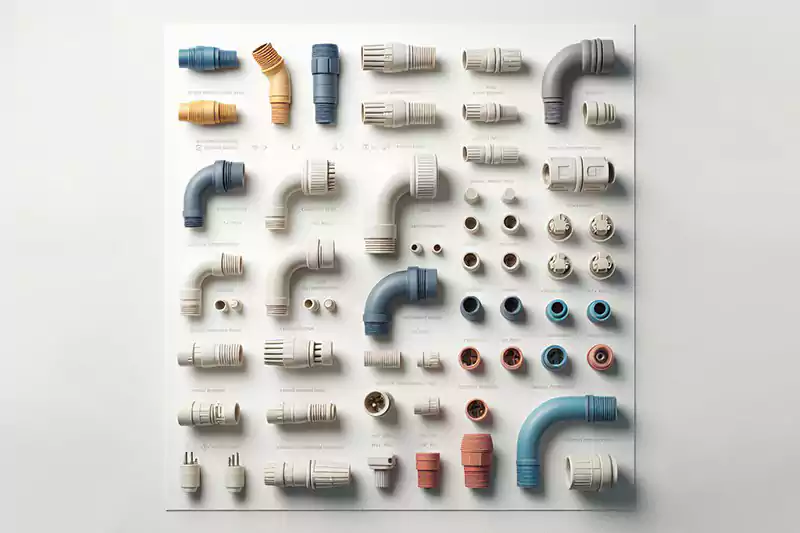
Um cotovelo de conduíte elétrico é um tipo de encaixe usado em instalações elétricas para mudar a direção de um sistema de conduíte. Ele é projetado para conectar duas seções de conduíte em um ângulo, permitindo que a fiação navegue por cantos, curvas ou mudanças de direção. Os cotovelos de conduíte são normalmente feitos de metal ou materiais não metálicos e estão disponíveis em vários tamanhos para acomodar diferentes diâmetros de conduíte.
Esses cotovelos são essenciais para rotear a fiação elétrica de forma segura e organizada. Eles garantem que a fiação esteja protegida contra danos e fornecem uma aparência limpa e profissional à instalação. Ao permitir que o sistema de conduíte navegue por obstáculos e mude de direção suavemente, os cotovelos de conduíte ajudam a manter a integridade da fiação elétrica e evitam riscos potenciais, como tensão do fio, curvas acentuadas ou danos acidentais.
Existem muitos tipos de cotovelos para conduítes elétricos, cada um projetado para aplicações específicas, e os cotovelos usados em diferentes países podem ser um pouco diferentes. Aqui estão alguns tipos mais comumente usados.
Cotovelos de 90 graus: Este tipo de cotovelo é amplamente usado em situações em que uma direção afiada é necessária dentro de um sistema de conduíte elétrico. Eles fornecem um ângulo reto preciso de 90 graus, permitindo que o conduíte navegue por cantos e mudanças de direção com eficiência ideal.
45 Degree Elbows: Esse tipo é geralmente usado quando é necessária uma curva mais gradual, em vez de um ângulo rígido, inclinando o conduíte em 45 graus.
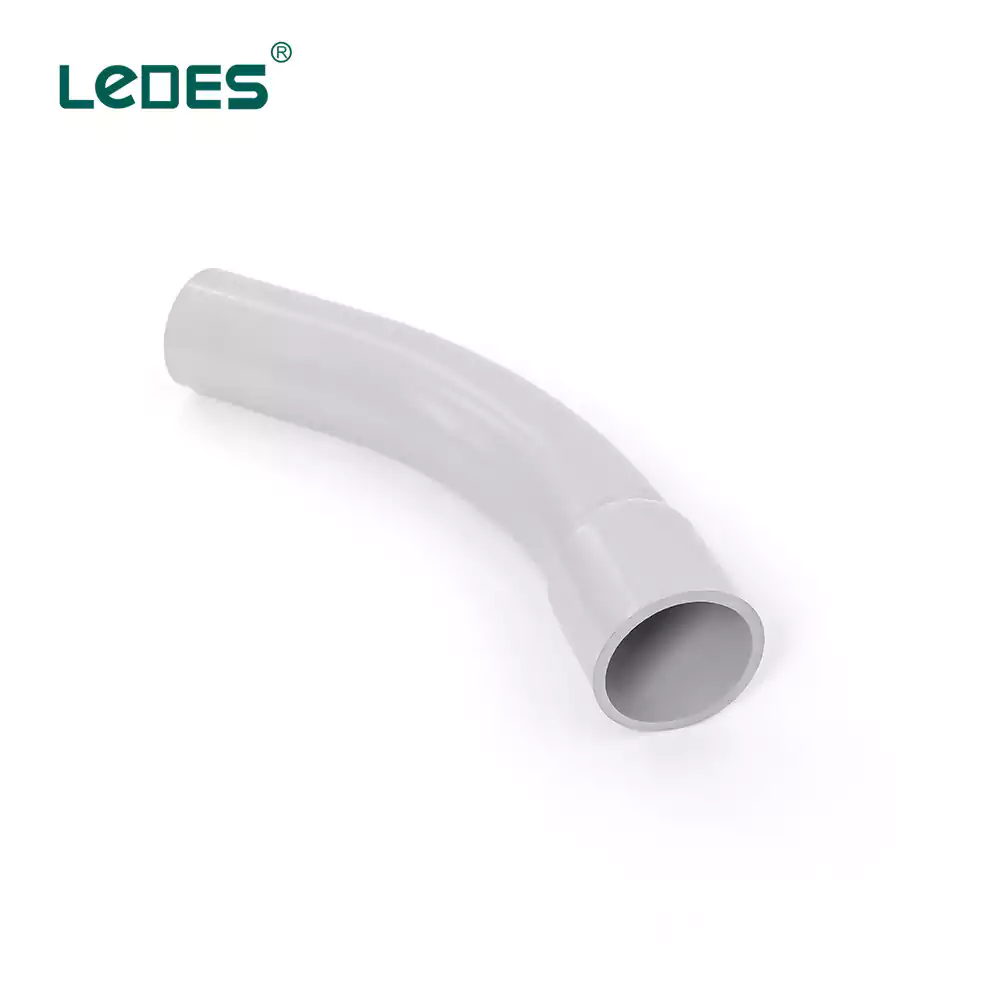
Cotovelos de 30 graus: Esse tipo de cotovelo cria uma curva moderada de 30 graus, proporcionando uma mudança de direção mais gradual em comparação a ângulos mais agudos, como 45 ou 90 graus.
22.5 Degree Elbow: Cotovelos de 22,5 graus são usados principalmente quando um sistema de conduíte precisa fazer uma leve curva ou navegar em um ângulo específico que não é tão acentuado quanto uma curva de 45 ou 30 graus.
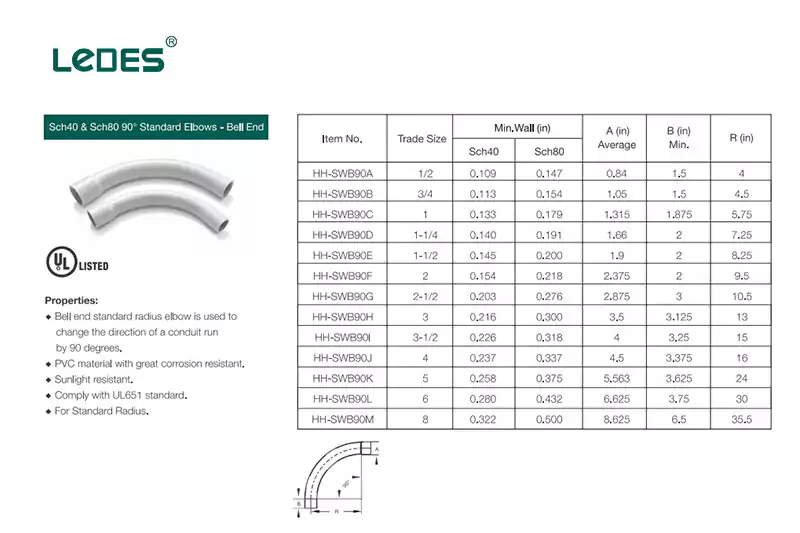
Nos Estados Unidos e no Canadá, esses tipos de cotovelos são amplamente utilizados para ajudar a fazer diferentes ângulos de curva no sistema de conduítes, mas as dimensões e alguns dos requisitos de desempenho são ligeiramente diferentes em comparação aos cotovelos padrão UL dos Estados Unidos e CSA do Canadá.
Aqui estão as dimensões para os padrões UL e CSA.
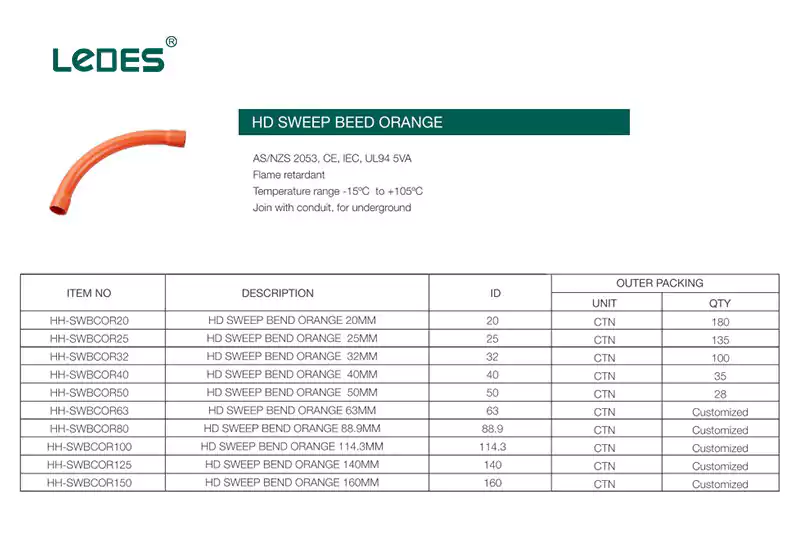
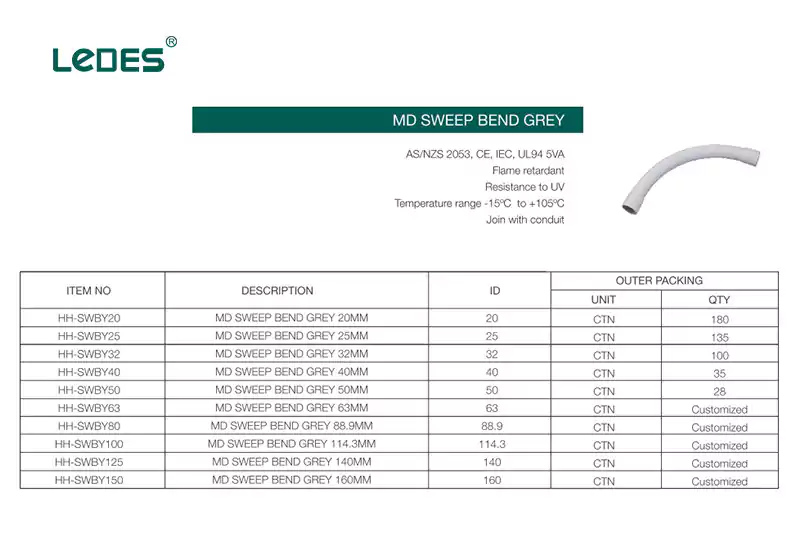
Na Austrália, os cotovelos e as dobras podem ser diferentes, eles têm ângulos diferentes, como 90 graus, mas existem muitos tipos diferentes, incluindo:
Heavy Duty Sweep Bends: A heavy-duty sweep bend is a robust conduit fitting designed to handle demanding applications where durability and strength are paramount. These bends are engineered to withstand heavy loads, extreme temperatures, and harsh environmental conditions while providing smooth changes in direction for electrical conduit systems.
Medium-Duty Sweep Bend: A medium-duty sweep bend provides a balance between strength and flexibility in conduit systems. These bends offer a moderate radius, making them suitable for a wide range of electrical installations.
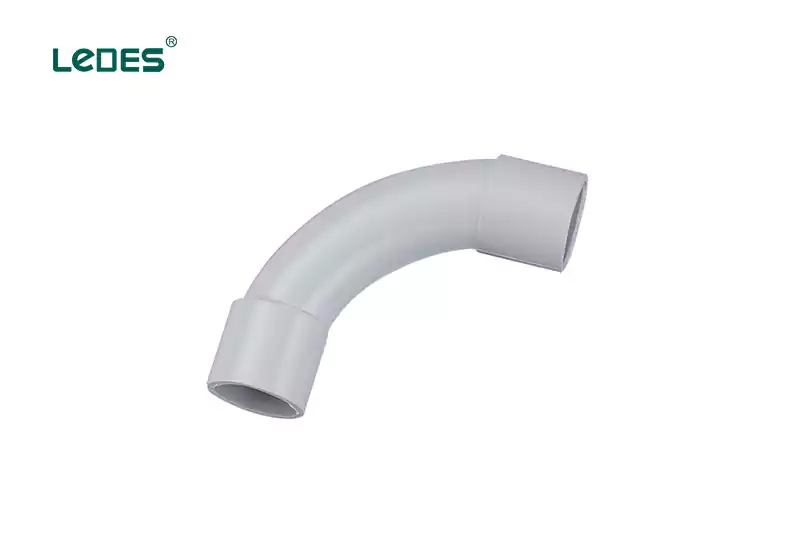
Curvatura padrão: A standard bend, also known as a standard elbow, is a general-purpose conduit fitting used to change the direction of a conduit system. These bends typically have a fixed angle, commonly 90 degrees, and are widely available for various conduit sizes.
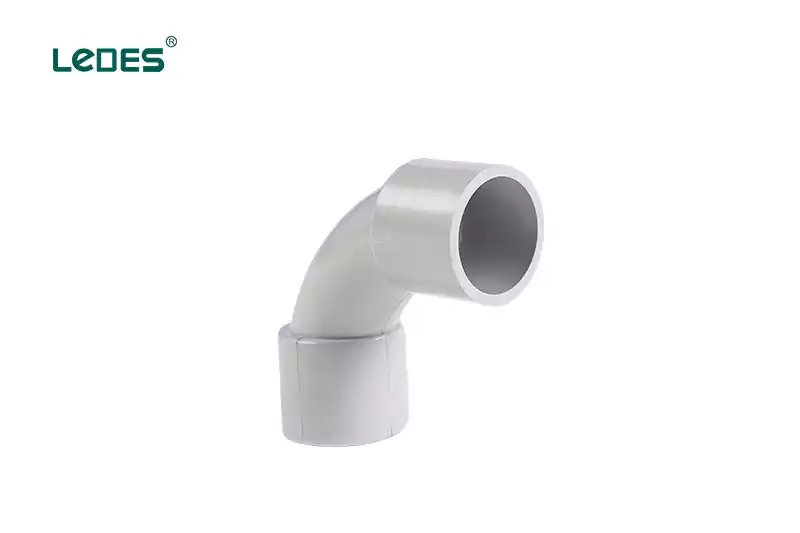
Solid Elbow: A solid elbow is a conduit fitting that provides a rigid and immovable change in direction for a conduit system. It is typically made of the same material as the conduit itself and is used when a permanent and secure angle is required.
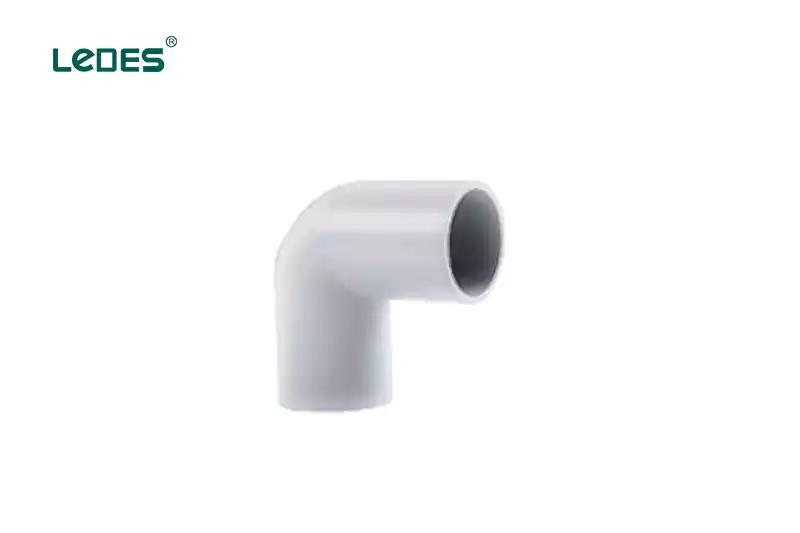
90 Degree Elbow: A bend for 90 degrees direction change, with no socket end.
Uma curva padrão, também conhecida como cotovelo padrão, é um encaixe de conduíte comumente usado que fornece um ângulo fixo de mudança de direção para um sistema de conduíte. Essas curvas geralmente têm um ângulo predeterminado, mais comumente 90 graus, e estão amplamente disponíveis em vários tamanhos para acomodar diferentes diâmetros de conduíte.
As principais características das curvas padrão incluem:
- Ângulo fixo: curvas padrão vêm com um ângulo fixo, como 90 graus, 45 graus ou outros ângulos comuns. Elas fornecem uma curva fechada no sistema de conduíte, permitindo mudanças de direção em um ângulo específico.
- Especificações predefinidas: curvas padrão são fabricadas com especificações predefinidas, incluindo o ângulo da curva e o diâmetro ou tamanho do conduíte para o qual foi projetada. Essas especificações são padronizadas e amplamente disponíveis no mercado.
Um cotovelo especial, também conhecido como cotovelo personalizado ou curva personalizada, refere-se a um encaixe de conduíte que é especificamente projetado e fabricado para atender a requisitos exclusivos em termos de curvatura e especificações. Ao contrário das curvas padrão, os cotovelos especiais oferecem a flexibilidade para personalizar o ângulo da curva e as dimensões de acordo com as necessidades específicas do projeto.
As principais características dos cotovelos especiais incluem:
- Curvatura personalizável: cotovelos especiais fornecem a capacidade de personalizar a curvatura, permitindo ângulos e curvas precisos no sistema de conduíte. Essa personalização permite que o encaixe corresponda aos requisitos específicos da instalação, acomodando obstáculos exclusivos, características arquitetônicas ou restrições de espaço.
- Especificações sob medida: Cotovelos especiais são conexões feitas sob encomenda que podem ser personalizadas com base em especificações específicas do projeto. Isso inclui o ângulo da curvatura, o raio da curvatura, o diâmetro ou tamanho do conduíte e outras dimensões conforme necessário.
- Processo de fabricação: Cotovelos especiais são normalmente fabricados por meio de processos de fabricação especializados que envolvem dobrar o conduíte no ângulo e curvatura desejados, garantindo um ajuste preciso para a aplicação específica.
Em resumo, a principal diferença entre uma curva padrão e um cotovelo especial está na capacidade de personalizar a curvatura e as especificações. Enquanto as curvas padrão oferecem ângulos fixos e especificações predefinidas, os cotovelos especiais fornecem a flexibilidade para adaptar o ângulo, o raio e as dimensões da curva para atender aos requisitos exclusivos do projeto.
Os tamanhos de cotovelos de conduítes elétricos podem variar entre os países, e as unidades de medida usadas também podem diferir. Aqui está uma explicação destacando as diferenças entre a América e a Austrália, junto com uma visão geral dos tamanhos comumente usados.
Na América, cotovelos de conduítes elétricos são frequentemente designados por tamanhos comerciais, que representam o diâmetro interno aproximado (ID) do conduíte. Tamanhos comerciais comuns para cotovelos incluem 1/2″, 3/4″, 1″, 1-1/4″, 1-1/2″, 2″, 2-1/2″, 3″, 3-1/2″, 4″ e maiores.
Na Austrália, os tamanhos de conduítes elétricos são normalmente medidos usando o sistema métrico, especificamente em milímetros (mm). Os tamanhos métricos mais comumente usados para cotovelos incluem 16 mm, 20 mm, 25 mm, 32 mm, 40 mm, 50 mm, 63 mm, 80 mm, 100 mm e maiores.
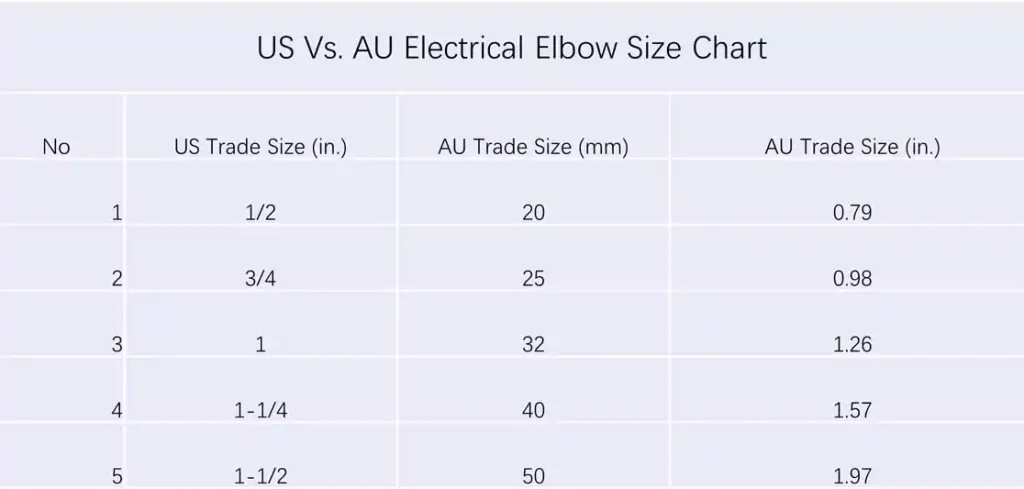
Curvas de conduítes elétricos podem ser classificadas em duas categorias principais de materiais: plástico e metal. Dentro de cada categoria, há materiais específicos comumente usados para curvas de conduítes.
- PVC (cloreto de polivinila): O PVC é uma escolha popular para curvas de conduíte de plástico devido à sua acessibilidade, natureza leve e facilidade de instalação. É resistente à corrosão e fornece bom isolamento elétrico. As curvas de conduíte de PVC são comumente usadas em aplicações residenciais e comerciais.
- Fibra de vidro: Curvas de conduíte de fibra de vidro são feitas de plástico reforçado composto de fibras de vidro embutidas em uma matriz de resina. Elas oferecem excelente resistência à corrosão, produtos químicos e temperaturas extremas. Curvas de conduíte de fibra de vidro são comumente usadas em ambientes industriais e severos, onde a durabilidade é crucial.
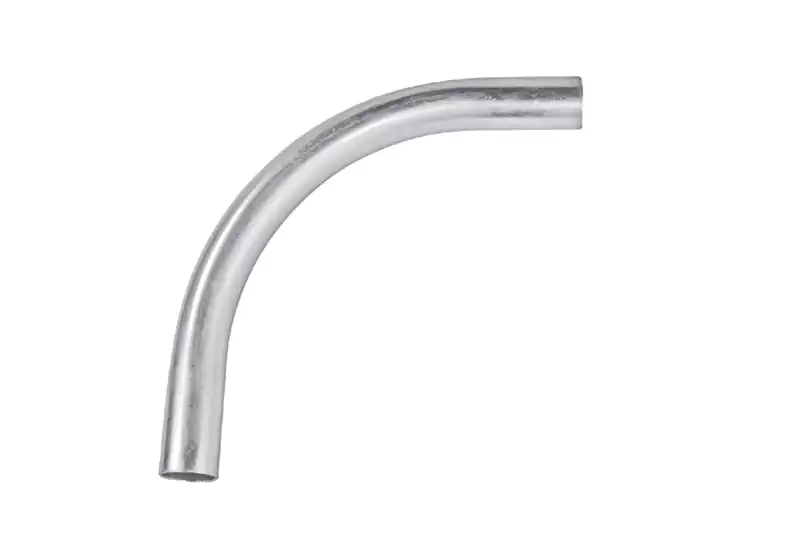
- Aço galvanizado: Curvas de conduíte de aço galvanizado são feitas de aço revestido com uma camada de zinco para fornecer resistência à corrosão. Elas são fortes, duráveis e amplamente utilizadas em aplicações comerciais e industriais. Curvas de conduíte de aço galvanizado são conhecidas por sua alta resistência mecânica e são adequadas para instalações externas.
- Aço: Curvas de conduíte de aço são feitas de aço simples sem nenhum revestimento protetor adicional. Elas oferecem robustez e resistência, mas são suscetíveis à ferrugem. Curvas de conduíte de aço são comumente usadas em ambientes industriais onde a durabilidade é essencial, mas a resistência à corrosão pode não ser uma preocupação primária.
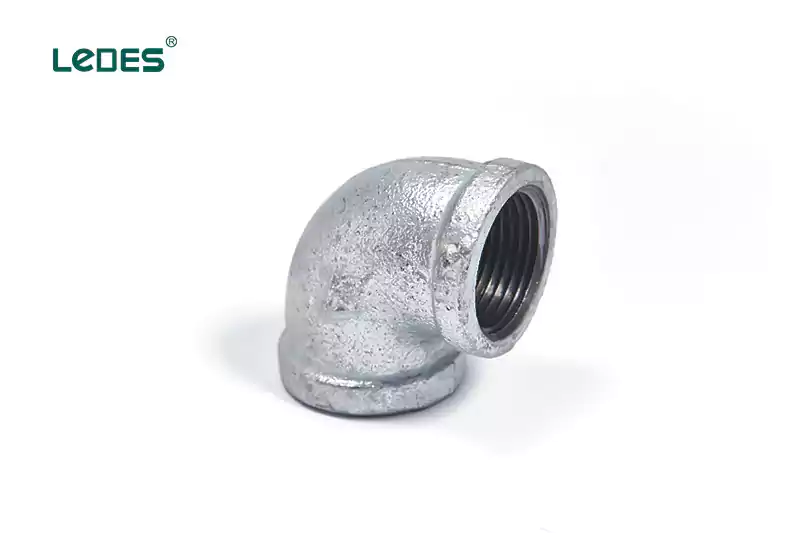
- Alumínio: Curvas de conduíte de alumínio são leves, resistentes à corrosão e fáceis de instalar. Elas são comumente usadas em aplicações residenciais e comerciais leves. Curvas de conduíte de alumínio são frequentemente escolhidas por seu baixo peso e resistência à ferrugem e corrosão.
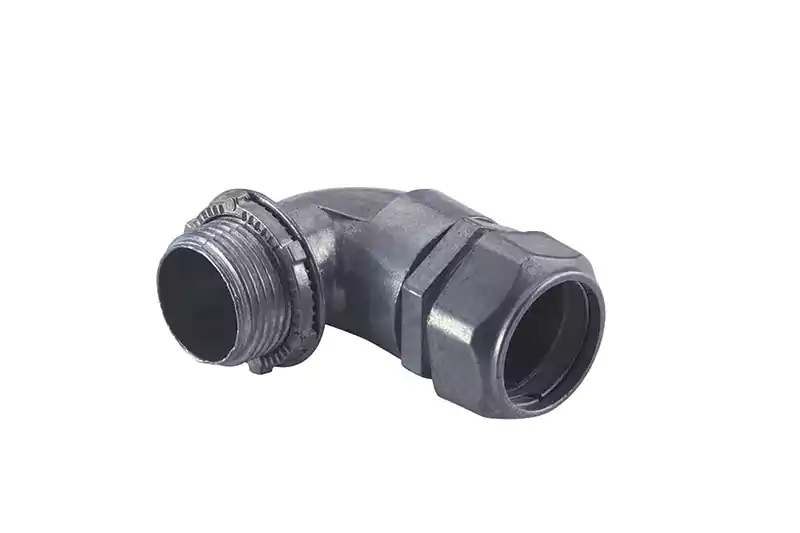
- Zinco: Curvas de conduíte de zinco são feitas de aço revestido com uma camada de zinco para proteção contra corrosão. Elas fornecem força moderada e resistência à corrosão. Curvas de conduíte de zinco são comumente usadas em instalações elétricas internas onde durabilidade e custo-benefício são importantes.
Ao selecionar o material para curvas de conduíte, é crucial considerar os requisitos do projeto. Materiais metálicos oferecem maior resistência e maior vida útil teórica, mas são mais pesados e mais propensos à ferrugem. Por outro lado, materiais plásticos não enferrujam, são mais leves e têm melhor custo-benefício. No entanto, eles podem ter menor resistência e uma vida útil teórica comparativamente menor do que curvas de metal.
Em última análise, a escolha do material de curvatura do conduíte depende de fatores como necessidades do projeto, orçamento, condições ambientais e o equilíbrio desejado entre durabilidade, resistência à corrosão, peso e custo.
Cotovelos são usados principalmente para mudar a direção de conduítes elétricos. Aqui está um resumo de seus usos:
- Mudança de direção: Cotovelos de conduíte são usados principalmente para mudar a direção de percursos de conduítes elétricos. Eles fornecem uma curva suave e gradual para o conduíte, permitindo que ele navegue em torno de obstáculos, cantos ou outros elementos estruturais. Os cotovelos vêm em vários ângulos, como 90 graus, 45 graus, 30 graus e 22,5 graus, fornecendo flexibilidade no roteamento do sistema de conduíte.
- Proteção do cabo: Cotovelos ajudam a proteger os cabos elétricos dentro do conduíte minimizando a curvatura excessiva. Quando os fios são submetidos a curvas acentuadas, isso pode forçar o isolamento e levar a danos ou desgaste prematuro. Cotovelos de conduíte oferecem uma mudança controlada e gradual na direção, reduzindo o risco de abrasão do isolamento, quebra de fios ou falhas elétricas.
- Otimização de espaço: Em espaços apertados ou áreas com espaço limitado para passagem de conduítes, os cotovelos são cruciais para otimizar a utilização do espaço. Ao permitir que o conduíte faça curvas fechadas ou navegue por cantos, os cotovelos permitem o roteamento eficiente dos fios e ajudam a garantir que o sistema de conduítes se encaixe no espaço disponível. Isso é particularmente importante em aplicações onde restrições de espaço ou características arquitetônicas representam desafios para a instalação.
- Acesso e Puxada: Certos tipos de cotovelos atendem a propósitos específicos relacionados ao acesso e à tração de fios. Os cotovelos de canto interno são projetados para uso em cantos onde o acesso ao canal é necessário. Eles apresentam tampas removíveis ou pontos de acesso, permitindo manutenção mais fácil ou tração de fios adicionais. Os cotovelos de tração, também conhecidos como cotovelos de varredura, têm uma curvatura de raio maior que facilita a tração de fios através do conduíte. Eles minimizam o risco de danos aos fios durante a instalação ou ao adicionar ou substituir cabos.
Ao incorporar cotovelos de conduíte em instalações elétricas, os profissionais podem obter roteamento de fios eficiente, proteger cabos, adaptar-se a espaços desafiadores e garantir acesso conveniente para manutenção ou modificações futuras. Esses acessórios versáteis desempenham um papel vital na criação de um sistema de conduíte bem projetado e funcional.
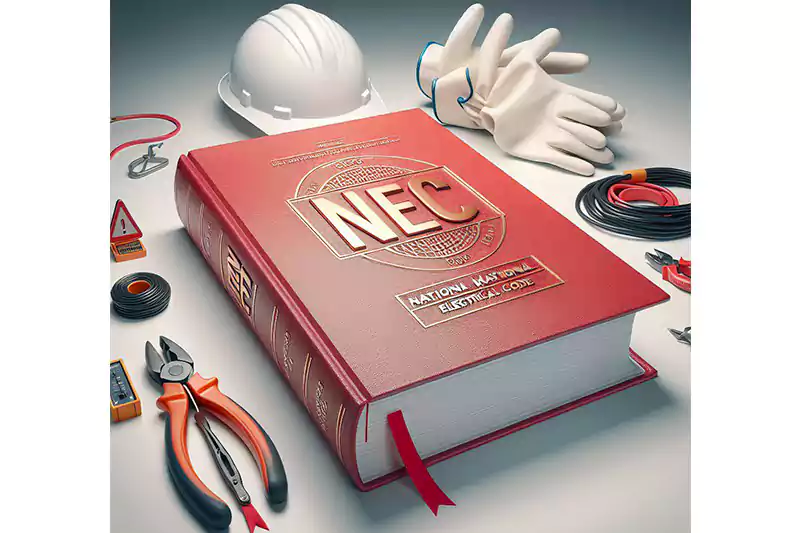
A conformidade do cotovelo de conduíte de PVC com os códigos locais pode variar entre diferentes regiões, como os Estados Unidos (UL651) e a Austrália (AS/NZS 2053). Aqui estão alguns exemplos das diferenças com base no UL651 e AS/NZS 2053:
- Tipos de Requisito
O padrão australiano, AS/NZS 2053, especifica requisitos de teste explícitos para diferentes tipos de cotovelos de conduíte, variando de serviço leve a serviço extrapesado. Ele também inclui requisitos numéricos específicos para resistência ao impacto. Além disso, o AS/NZS 2053 exige marcação no cotovelo do conduíte, onde o tipo de serviço correspondente, como Serviço Leve (LD) ou Serviço Pesado (HD), é impresso na superfície do conduíte. Isso permite fácil identificação da classificação de resistência do conduíte. Em contraste, o UL651 não tem requisitos específicos para marcação dos cotovelos do conduíte.
- Definições de teste de chama
A definição e os procedimentos de teste para resistência à chama também diferem entre UL651 e AS2053/NZS 2053:
A UL651 afirma que um encaixe (incluindo cotovelos de conduíte) não deve continuar a arder por mais de 5 segundos após a terceira aplicação da chama de teste. Ela também especifica que nenhuma partícula ou gota em chamas deve cair do encaixe durante ou após qualquer aplicação da chama de teste.
AS/NZS 2053 descreve o procedimento de teste de chama em detalhes. Ele requer que o queimador seja apoiado em um ângulo de 45 ±2° em relação à vertical. A chama é aplicada às amostras de conduíte de modo que a distância do topo do tubo do queimador até o mesmo, medida ao longo do eixo da chama, seja de 100±10 mm, e o eixo da chama cruze com a superfície da amostra em um ponto de 100±5 mm da extremidade superior do grampo inferior, e de modo que o eixo da chama cruze com o eixo da amostra.
A chama é aplicada por um período de 60 ±1 s, e a amostra não deve ser movida durante o teste. A AS2053 também especifica que o teste de chama deve ser conduzido em três amostras.
Observe que as informações fornecidas são provenientes da Standards Australia e da UL (Underwriters Laboratories Inc.), e essas organizações detêm a autoridade final na interpretação dos padrões mencionados.
Concluindo, as variações nos padrões de teste entre diferentes regiões podem resultar em diferenças nos indicadores de desempenho para cotovelos de conduíte. No entanto, desde que os produtos estejam em conformidade com os requisitos do código local, sua qualidade e adequação para uso são garantidas.
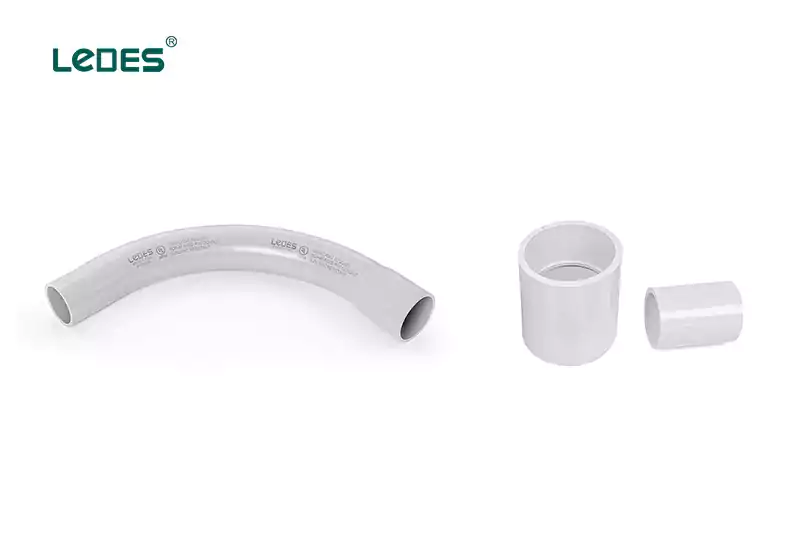
Aparência:
Primeiramente, os dois podem ser facilmente distinguidos com base em sua aparência. Um cotovelo de conduíte normalmente tem um formato curvo ou dobrado, lembrando uma seção dobrada de conduíte. Por outro lado, um acoplador tem um design reto, lembrando uma seção reta de conduíte.
Propósito:
A principal distinção entre cotovelos de conduíte e acopladores está em seu design e propósito. Os cotovelos de conduíte são usados principalmente para mudar a direção de um percurso de conduíte. Eles vêm em curvas pré-formadas de 45 graus e 90 graus, adequadas para conduítes metálicos e não metálicos. Os cotovelos de canto interno e de puxar são particularmente úteis em espaços apertados ou quando o acesso ao canal é necessário.
Por outro lado, acopladores são comumente empregados para unir um conduíte a um soquete montado na superfície ou caixa de interruptor. Eles fornecem um meio de conectar seções separadas de conduíte, facilitando a continuação do conduíte ou conectando-o a uma tomada ou caixa de junção.
Devido aos seus designs distintos e aplicações pretendidas, é importante evitar confusão entre cotovelos de conduíte e acopladores durante os processos de aquisição e construção.
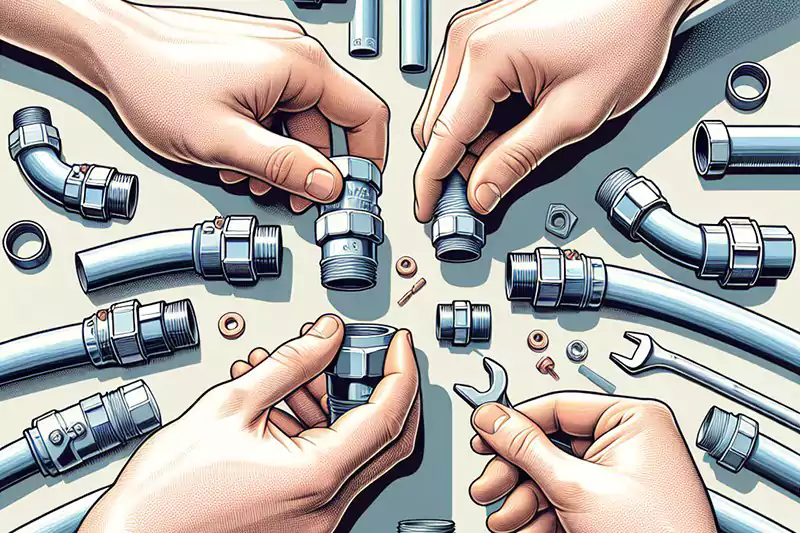
- Reúna os materiais e ferramentas necessários:
Cotovelos de conduíte de metal
Tubos de conduíte metálicos
Conectores ou acoplamentos de conduíte
Serra ou cortador de tubos
Ferramenta de rebarbação ou faca utilitária
Chave de fenda ou chave inglesa (se necessário para conectores)
- Meça e corte os tubos de conduíte metálicos:
Determine o comprimento desejado dos tubos de conduíte que levam ao cotovelo.
Use uma serra ou cortador de tubos para cortar os tubos de conduíte de metal no comprimento apropriado. Certifique-se de que os cortes sejam retos e limpos.
- Prepare os cotovelos do conduíte metálico:
Solte quaisquer parafusos ou porcas de fixação nos cotovelos para abri-los.
- Conecte os tubos de conduíte metálicos aos cotovelos:
Insira uma extremidade do tubo de conduíte metálico na extremidade aberta do cotovelo.
Se o cotovelo de metal tiver parafusos de fixação ou porcas de segurança, aperte-os firmemente para manter o tubo de conduíte no lugar.
Se estiver usando um acoplamento ou conector, siga as instruções do fabricante para conectar o tubo de conduíte ao cotovelo.
- Conecte os tubos de conduíte metálicos restantes:
Repita o processo descrito na etapa 4 para conectar tubos de conduíte metálicos adicionais à outra extremidade do cotovelo.
Use acoplamentos ou conectores para unir firmemente os tubos de conduíte de metal. Aperte-os corretamente usando uma chave de fenda ou chave inglesa.
- Fixe o conjunto do conduíte metálico:
Certifique-se de que o conjunto do conduíte metálico esteja devidamente alinhado e apoiado.
Use cintas ou braçadeiras de conduíte para prender o conduíte a uma parede ou outra superfície adequada.
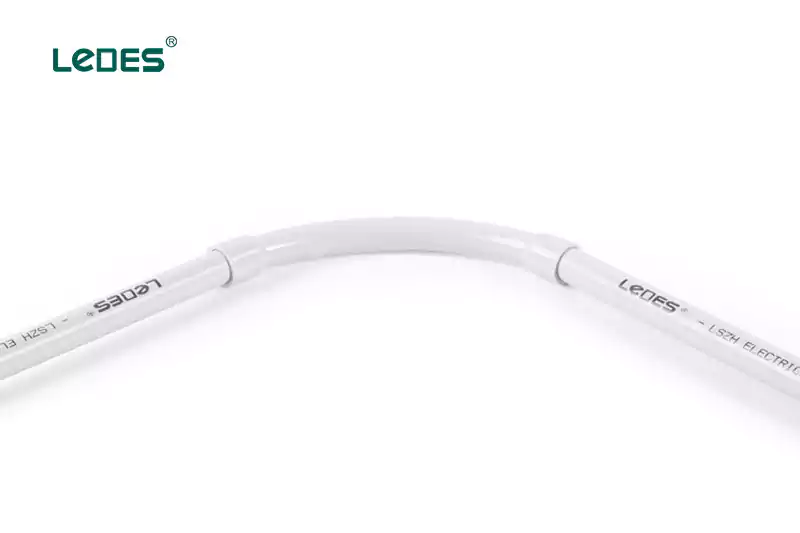
- Reúna os materiais e ferramentas necessários:
Cotovelos de conduíte de plástico
Tubos de conduíte de plástico
Conectores ou acoplamentos de conduíte
Serra ou cortador de tubos
Ferramenta de rebarbação ou faca utilitária
Conduta de cimento
- Meça e corte os tubos de conduíte de plástico:
Determine o comprimento desejado dos tubos de conduíte que levam ao cotovelo.
Use uma serra ou cortador de tubos para cortar os tubos de conduíte de plástico no comprimento apropriado. Certifique-se de que os cortes sejam retos e limpos.
- Prepare os cotovelos de conduíte de plástico:
Limpe as extremidades do conduíte e o interior do cotovelo com uma ferramenta de rebarbação ou uma faca para remover quaisquer rebarbas ou bordas ásperas.
- Conecte os tubos de conduíte de plástico aos cotovelos:
Aplique cimento para conduítes na parte interna do cotovelo e na parte externa do tubo plástico.
Insira o tubo de conduíte no cotovelo e segure-o firmemente por alguns segundos para permitir que o cimento endureça.
- Conecte os tubos de conduíte de plástico restantes:
Repita o processo descrito na etapa 4 para conectar tubos de conduíte plásticos adicionais à outra extremidade do cotovelo.
Use acoplamentos ou conectores para unir com segurança os tubos de conduíte de plástico. Siga as instruções do fabricante para instalação.
- Prenda o conjunto do conduíte plástico:
Certifique-se de que o conjunto do conduíte plástico esteja devidamente alinhado e apoiado.
Use cintas ou braçadeiras de conduíte para prender o conduíte a uma parede ou outra superfície adequada.
Lembre-se de seguir todas as instruções específicas fornecidas pelo fabricante dos cotovelos de conduíte e conectores que você está usando. Além disso, siga os códigos e regulamentos elétricos locais ao instalar conduítes para fins de fiação elétrica. Se não tiver certeza sobre algum aspecto da instalação, é aconselhável consultar um eletricista ou profissional qualificado.
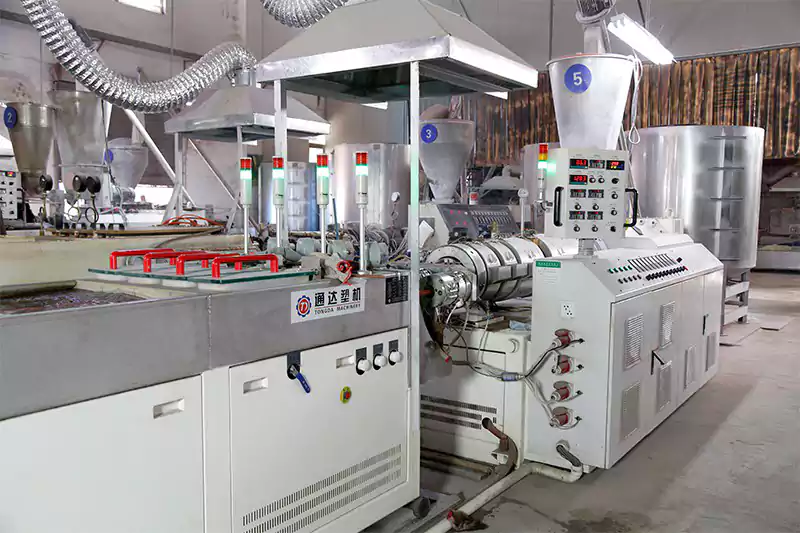
Aqui está um esboço geral do processo de fabricação de cotovelos de plástico em PVC:
- Preparação de resina de PVC: O primeiro passo é preparar a resina de PVC misturando-a com aditivos e estabilizantes para obter as propriedades desejadas como resistência, flexibilidade e resistência aos raios UV e produtos químicos.
- Extrusão de tubos de PVC: A resina de PVC é alimentada em uma máquina extrusora, onde é aquecida e derretida para formar um composto de PVC fundido. O PVC fundido é então empurrado através de uma matriz, o que lhe dá a forma de um tubo contínuo. O tubo extrudado é resfriado e solidificado à medida que passa por um banho-maria ou câmara de resfriamento.
- Preparação do molde: As cavidades do molde são preparadas para o formato do cotovelo. Esses moldes são normalmente feitos de metal e consistem em duas metades que se encaixam. As cavidades do molde são usinadas com precisão para criar o formato e as dimensões desejadas do cotovelo.
- Moldagem por injeção: Nesta etapa, os tubos de PVC resfriados e solidificados provenientes do processo de extrusão são cortados em comprimentos específicos e alimentados em uma injetora. A máquina de moldagem por injeção consiste em um cilindro aquecido e um mecanismo de parafuso. Os pedaços de tubo de PVC são introduzidos no barril, onde são derretidos e transportados pela rosca até a cavidade do molde.
- Moldando o formato do cotovelo: O PVC fundido é injetado na cavidade do molde a alta pressão. O molde é projetado para criar o formato do cotovelo, incluindo o ângulo e o raio desejados. O material PVC preenche as cavidades do molde e assume o formato do cotovelo.
- Resfriamento e solidificação: Após o material de PVC ser injetado no molde, ele pode esfriar e solidificar. O resfriamento pode ser acelerado através do uso de canais de resfriamento ou sprays de água. Esta etapa garante que o material de PVC mantenha sua forma e estabilidade.
- Abertura e ejeção do molde: Assim que o material de PVC solidificar, o molde é aberto e o cotovelo de PVC recém-formado é ejetado da cavidade do molde. A ejeção pode ser facilitada através do uso de pinos ejetores ou jatos de ar.
- Corte e acabamento: Os cotovelos de PVC ejetados podem apresentar excesso de material ou rebarbas que precisam ser removidas. O corte é realizado para remover quaisquer porções indesejadas e obter uma superfície lisa e acabada. Isso pode ser feito manualmente ou usando equipamento de corte automatizado.
- Controle e inspeção de qualidade: Os cotovelos de PVC passam por verificações de controle de qualidade para garantir que atendam às especificações e padrões exigidos. Isto pode incluir verificações dimensionais, inspeções visuais e testes de resistência e durabilidade.
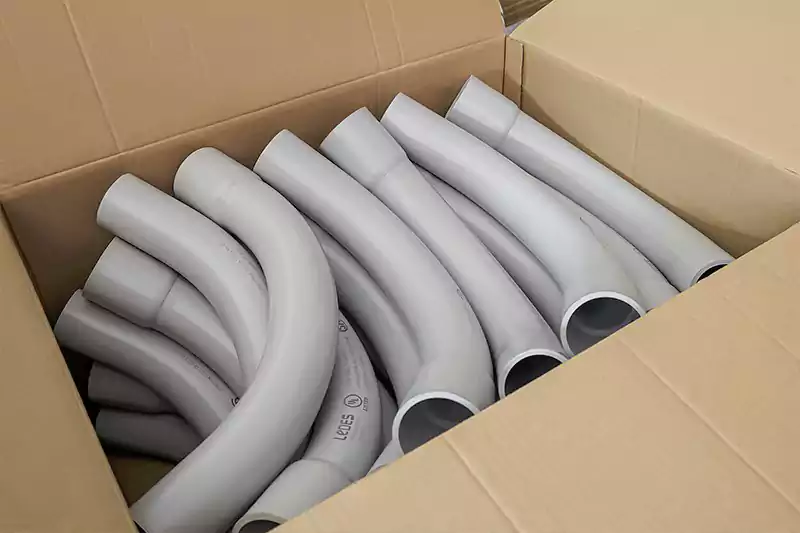
- Embalagem e distribuição: Depois de passar pelas verificações de controle de qualidade, os cotovelos de PVC são embalados e preparados para distribuição. Podem ser agrupados, embalados ou colocados em paletes, dependendo dos padrões de embalagem do fabricante. Os cotovelos de PVC embalados são então enviados aos distribuidores ou clientes.
Avalie as necessidades básicas do produto com base no seu projeto ou ambiente de uso. Por exemplo, determine se você precisa dos cotovelos para serem embutidos em edifícios residenciais padrão, para uso externo de longo prazo ou se eles serão expostos a condições de umidade. Considerando as vantagens e desvantagens de vários produtos para cotovelos, podemos ajudá-lo a fazer a escolha certa. Se você é um empreiteiro ou distribuidor de projetos, entre em contato conosco para obter mais conselhos sobre compras.

Selecione produtos que se ajustem ao seu projeto dentro do seu orçamento. Isso garante que você atenda aos requisitos do projeto, minimizando os custos de aquisição e obtendo produtos de boa qualidade. Além do custo de aquisição dos produtos, considere os custos de transporte e instalação. Por exemplo, como mencionado anteriormente, os cotovelos metálicos são mais pesados, resultando em maiores despesas de transporte e instalação. Portanto, é importante levar em consideração esses custos ao alocar seu orçamento total.
Com base nos requisitos de instalação e construção, determine os padrões de quantidade e qualidade necessários. Isso permite que você compre a quantidade desejada de cotovelos dentro do seu orçamento e, ao mesmo tempo, atenda aos requisitos de qualidade.
Diferentes tipos de cotovelos estão disponíveis em várias marcas. A compra de produtos de marcas conceituadas pode ter um preço um pouco mais alto, mas a qualidade é significativamente melhor. Marcas conhecidas passaram por certificações locais. A compra de marcas desconhecidas pode resultar em possíveis problemas de qualidade e as perdas resultantes podem exceder em muito o valor do produto. Se os preços das marcas locais forem muito altos ou você precisar de compras em grandes quantidades, considere comprar diretamente de fabricantes, como Ledes. Como fabricante, a Ledes opera como uma fábrica sem intermediários, oferecendo preços relativamente mais baixos. Além disso, com mais de 14 anos de experiência em exportação e atendendo milhares de clientes, a Ledes garante a entrega pontual das mercadorias assim que você faz seu pedido.
Se você quiser saber mais sobre nossos produtos, Por favor, clique aqui para nos enviar um email.
Concluindo, os cotovelos de conduíte desempenham um papel crucial nas instalações elétricas, proporcionando flexibilidade e roteamento eficiente de fios e cabos. Este artigo forneceu uma visão geral abrangente dos cotovelos de conduíte, abordando seus tipos, materiais, tamanhos e considerações de instalação.
Lembre-se de que selecionar os cotovelos de conduíte corretos é essencial para uma instalação elétrica segura e eficiente. Ao escolher nossos produtos de alta qualidade, você pode garantir desempenho confiável e tranquilidade para seus projetos.
Se você estiver interessado em cotovelos de conduíte, como fabricante, oferecemos preços de atacado de cotovelos de PVC. Você pode enviar um formulário de contato ou envie-nos um e-mail para solicitar um catálogo de produtos e cotação gratuitamente. Dedicamo-nos a fornecer cotovelos de conduíte de alta qualidade e excelente atendimento ao cliente. Não hesite em entrar em contato conosco para obter mais informações ou fazer um pedido. Estamos ansiosos para servi-lo!



